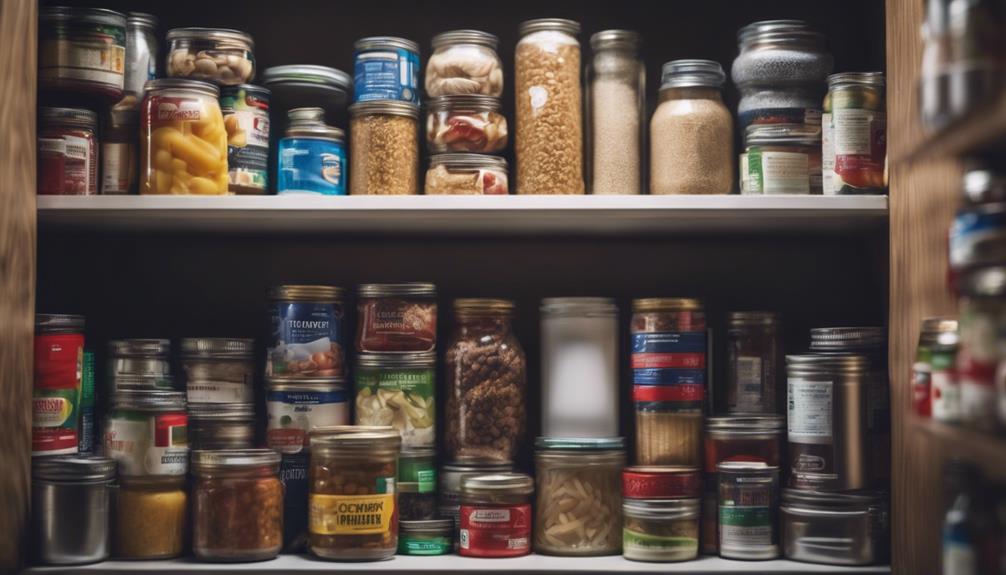Stock up your preppers pantry to enhance safety. Prioritize cool, dark storage spots. Preserve using canning and vacuum sealing. Choose long shelf-life foods and maintain quality. Protect from heat, moisture, and pests. Opt for dehydrated foods, canned goods, and airtight storage for grains and legumes. Include balance with carbs, proteins, and fats. Organize efficiently, use airtight containers, and rotate supplies. Stock up on staples like rice, pasta, canned goods, and beans. Consider freeze-dried and dehydrated options for longevity. Add proteins, vitamins, healthy fats, and hydration for a well-rounded stockpile. Enhance safety by proper organization and preservation.
Key Takeaways
- Store a variety of shelf-stable foods for emergencies.
- Include water, hydration options, and purification methods.
- Organize, label, and rotate supplies for efficiency.
- Prioritize long-lasting and nutrient-dense foods.
- Safeguard stockpile from pests, moisture, and spoilage.
Essential Survival Food Storage Tips
When storing survival foods, prioritize cool, dark locations to safeguard them from heat, moisture, and pests. This helps prolong their shelf life and maintains their quality for when you truly need them.
Utilize preservation methods such as canning, dehydrating, and vacuum sealing to further extend the longevity of your stockpile. These methods not only increase the shelf life of your foods but also help retain their nutritional value.
When selecting survival foods, consider shelf life as an important factor. Opt for items that have a long shelf life to make sure they remain edible for an extended period.
Choosing the Right Survival Foods

Consider various factors such as shelf life, nutritional value, and storage convenience when determining the best survival foods for your preppers pantry.
Opt for dehydrated foods with long shelf lives and canned goods for essential nutrients in your emergency food supply.
Store grains and legumes in airtight containers to maintain freshness and incorporate plant-based proteins for sustainable energy.
Guarantee your food storage includes fruits, vegetables, and supplements to meet essential nutrient requirements.
Diversify your options by including freeze-dried, dehydrated, and canned foods to create a well-rounded and nutritious preppers pantry.
When choosing survival foods, prioritize items that provide a balance of carbohydrates, proteins, and fats to sustain you during emergencies.
Remember to rotate your food storage to prevent spoilage and regularly check expiration dates to maintain the quality of your supplies.
Planning Your Pantry Space

When planning your pantry space, it's crucial to focus on efficient organization, maximizing storage space, and ensuring accessibility and convenience.
By allocating space thoughtfully and using airtight containers, you can protect your emergency food supplies and make the most of your pantry area.
Organize your shelves strategically to easily locate different food categories and consider rotating supplies regularly for freshness and minimal wastage.
Efficient Pantry Organization
Use clear bins, shelves, and racks to effectively organize your pantry space for easy access and meal planning. Categorize foods by type such as grains, legumes, and canned goods to guarantee you save time when cooking and to keep track of your inventory. Label containers with expiration dates to make sure you use older items first and minimize food waste. Consider the temperature and humidity levels in your pantry to maintain food quality and prevent spoilage. Additionally, create a designated area for emergency supplies like water, first aid kits, and tools for quick access during crises. To help you visualize how to organize your pantry efficiently, take a look at the table below:
| Food Type | Storage Container | Location in Pantry |
|---|---|---|
| Grains | Clear bins | Eye level |
| Legumes | Shelves | Bottom shelf |
| Canned Goods | Racks | Door shelves |
Maximizing Storage Space
Maximize your pantry space by strategically organizing food items based on size, shape, and frequency of use to enhance storage efficiency. When planning your pantry space, consider the following tips:
- Vertical Storage Solutions: Utilize shelves, racks, and hanging organizers to make the most of limited space and keep shelf-stable items easily accessible.
- Labeling System: Label containers and shelves to quickly locate items and prevent food spoilage. This simple step can also help prevent waste from forgotten supplies.
- Rotation of Supplies: Regularly rotate food items to guarantee older products are used first, maintaining freshness and reducing the risk of expiration for shelf-stable goods.
- Invest in Storage Solutions: Consider stackable storage bins, clear containers, and adjustable shelving to customize and optimize your pantry storage space efficiently.
Accessibility and Convenience
Plan your pantry space strategically to guarantee easy access to essential items during emergencies by organizing shelves with accessibility and convenience in mind.
Utilize storage bins, baskets, and labels to keep your pantry neat and efficient for quick inventory checks.
Consider rotating stock by placing newer items behind older ones to make certain nothing expires or goes to waste.
Keep frequently used items at eye level for quick retrieval, reserving higher or lower shelves for less used or bulk items.
Designate specific areas for different categories of food items such as grains, canned goods, and snacks for better organization.
By implementing these accessibility principles, you can create a pantry space that isn't only well-organized but also user-friendly during times of need.
Shelf-Stable Pantry Staples

Stock your pantry with shelf-stable staples for long-lasting emergency food supplies. These items play an important role in emergency preparedness by providing sustenance during crises.
Here are four essential shelf-stable pantry staples to take into account stocking up on:
- Rice: A versatile staple with a long shelf life, rice can be a reliable source of carbohydrates and energy during emergencies.
- Pasta: Easy to prepare and comforting, pasta is a great addition to your pantry for quick and filling meals.
- Canned Goods: Items like beans, vegetables, and fruits in cans are convenient and have extended expiration dates, ensuring you have essential nutrients on hand.
- Dried Beans: Rich in protein and fiber, dried beans are nutritious and can be stored for a long time, making them ideal for emergency situations.
Freeze-Dried and Dehydrated Foods

To enhance your emergency food supplies with long-lasting options, consider incorporating freeze-dried and dehydrated foods into your pantry. In the face of uncertainties like a global pandemic, having these shelf-stable options can provide you with peace of mind and guarantee you have access to nutritious meals when fresh options may not be readily available.
Freeze-dried foods, retaining 97% of their nutrients and lasting up to 25 years, offer a reliable source of sustenance. On the other hand, dehydrated foods, with a shelf life of 15-25 years when stored correctly, provide a lightweight and space-efficient alternative.
Whether it's fruits, vegetables, meats, or full meals, both freeze-dried and dehydrated options come in a variety of choices, allowing you to diversify your emergency food stockpile. Remember to rehydrate these foods before consumption by adding water or cooking to ensure food safety and retain their taste and texture.
Power-Packed Protein Sources

For sustained energy and muscle support in your preppers pantry, incorporate protein-rich foods like canned tuna, chicken, and beans.
When stocking up on protein-packed options for emergencies, consider the following:
- Beef Jerky: A long-lasting protein source that requires no refrigeration, making it ideal for on-the-go nutrition.
- Protein Bars: Convenient and efficient, these bars provide a quick protein boost when you need it most.
- Powdered Whey: Versatile and easy to store, powdered whey can be added to various dishes or mixed with water for a protein shake.
- Peanut Butter: A shelf-stable option high in protein, healthy fats, and calories, perfect for a quick and filling meal.
Including these protein-packed options in your prepping supplies ensures you meet your daily protein requirements and have a well-rounded diet during emergencies.
Additionally, stock up on items like canned salmon, canned sardines, lentils, and quinoa to diversify your protein intake and enhance your meal options in your preppers pantry.
Maximizing Vitamins and Minerals

To enhance your emergency preparedness and boost your overall health, focus on maximizing vitamins and minerals in your preppers pantry.
Including a variety of fruits and vegetables is essential as they're rich sources of essential nutrients.
Opt for supplements like multivitamins to make sure you meet your daily nutrient requirements, especially during emergencies. Remember to store vitamin packs in a cool, dark place to maintain their potency over time.
Consider adding dried fruits and nuts to your survival stash as they provide a natural source of essential vitamins and minerals.
It's important to rotate your stock of perishable vitamin-rich foods regularly to ensure freshness and nutritional value.
Healthy Fats and Sweeteners

Incorporate healthy fats like coconut oil and nut butters for essential nutrients and flavor in your pantry, ensuring a well-rounded selection of ingredients for your preppers stash.
When stocking up on fats and sweeteners, remember to choose options that not only add taste but also help you stay healthy. Here are some tips to guide your selections:
- Choose Wisely: Opt for natural sweeteners such as honey and maple syrup to satisfy your sweet tooth without artificial additives.
- Cooking Essentials: Consider olive oil, avocado oil, and ghee as healthy fat options for your cooking and baking needs.
- Nutrient Boost: Incorporating healthy fats and sweeteners into your meals can provide essential nutrients for a balanced diet.
- Variety Matters: Stock up on a variety of healthy fats and sweeteners to enhance both the taste and nutritional value of your prepper pantry meals.
Hydration and Beverage Choices

Consider stocking up on essential beverages and hydration options to guarantee you're prepared for emergencies and stay properly hydrated. In emergency situations, two cases of water should be a priority to make certain an adequate supply for drinking and sanitation needs.
Additionally, incorporating electrolyte drinks, powdered mixes, or hydration tablets into your pantry can provide variety and essential nutrients to keep you going. For comfort and warmth, include herbal teas, coffee, and hot chocolate packets in your emergency supplies.
Opt for long shelf-life drinks like canned juices, shelf-stable milk, or sports drinks to maintain hydration levels over time. Don't overlook the importance of water purification tablets or filters in case your water supply runs out during a crisis.
Organizing and Preserving Your Stockpile

Organizing and preserving your stockpile requires strategic categorization, regular rotation, and proper storage methods to guarantee a well-managed and reliable emergency food supply.
To make certain your food stockpile remains fresh and accessible, make sure to:
- Organize by Type: Group similar items together for easy access and inventory tracking.
- Rotate Regularly: Check expiration dates and use older items first to prevent wastage.
- Use Proper Storage: Opt for airtight containers like mason jars and Mylar bags to protect against moisture and pests.
- Label Everything: Clearly mark containers with contents and dates to maintain inventory control and freshness.
Frequently Asked Questions
What Food Should Preppers Stock up On?
You should stock up on shelf-stable foods like rice, beans, and canned goods for emergencies. Including grains, legumes, and dehydrated foods in your pantry guarantees sustainable energy. Diversify with fruits, vegetables, and supplements for health.
What Prepper Supplies Should I Stock up On?
You should stock up on essential prepper supplies like canned goods, water containers, first aid kits, tools, and communication devices. Don't forget medications, hygiene products, and protective gear. Being prepared guarantees safety during emergencies. Additionally, consider adding items like batteries, fire-starting tools, and blankets to ensure comfort and survival under various conditions. Rotate and check expiration dates regularly to keep your preppers essential stockpile items fresh and functional. Planning ahead and maintaining a balanced inventory will give you peace of mind in the face of unpredictable events.
What Foods to Stock up on for Long Term Storage?
When prepping for long-term storage, focus on grains like rice, oats, and quinoa, canned goods such as beans and vegetables, dehydrated foods like jerky and fruits, nuts and seeds, and essential staples like sugar, salt, and spices for flavor and nutrition.
What Is the Best Canned Food to Stockpile?
When preparing your pantry for emergencies, prioritize canned goods high in protein like beans, tuna, and chicken. Opt for pop-top lids for convenience. Remember to rotate your stockpile regularly, using older cans first for freshness.
Conclusion
To wrap up, by stocking up on essential survival foods and organizing your pantry effectively, you can guarantee that you and your loved ones are prepared for any emergency. Remember to rotate your stockpile, stay hydrated, and focus on long-lasting shelf-stable options.
Stay safe, stay prepared, and be ready for whatever the future may hold. Your peace of mind is worth the effort of building a well-stocked preppers pantry.










